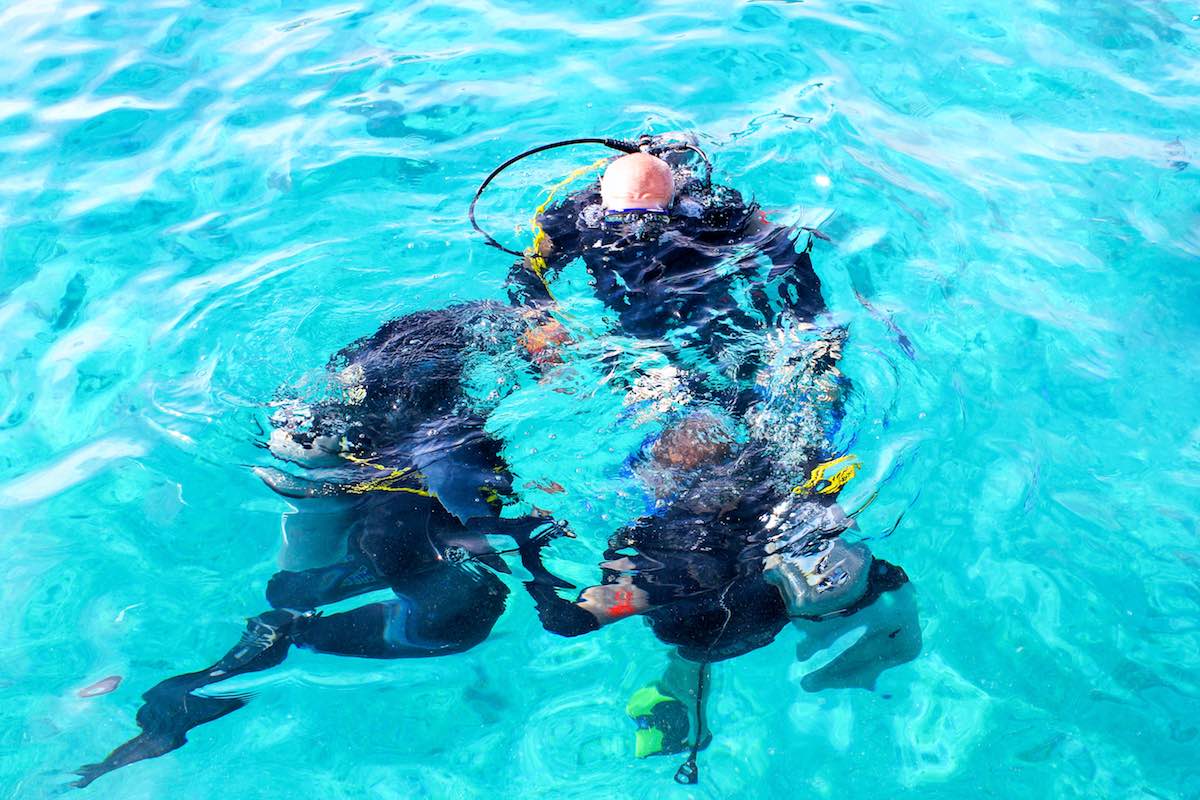Learn about the Buddy Check in Scuba Diving
If you are a certified diver, you have probably heard about the predive safety check or what we call the buddy check.
When you start diving more and more, buddy checks become second nature and it becomes a habit to do them before every dive as a prudent and conservative diver.
A Buddy Check is an important part of ensuring the safety of a diver and performing pre-dive safety check steps, help to make sure that all the equipment is working properly.

Ensure Diver Safety
It also gives you a chance to verify your dive buddy’s diving equipment and see how it works, as they may not be using the same equipment or configuration, which is another important step before entering the water.
In the unlikely event of an emergency, you will be better capable of handling the situation if you understand the configuration before entering the water.
How to perform a buddy check gets taught to student divers in the entry level courses of the PADI curriculum, which are the PADI Scuba Diver or PADI Open Water Diver courses.
There are 5 steps to the buddy check and in the PADI educational materials you will often see the acronym ‘BWRAF’ come up. Every letter is the first letter of one of the 5 steps.
BWRAF Acronym – Scuba Diving
Over the years, PADI and their instructors have been very creative and have come up with different meanings to remember these first letters.
PADI uses the words Begin with Review and Friend on the PADI Dive Planning slate that is used during the Open Water course.
Others you may hear are: Bruce Willis Ruins All Films or Bruce Willis Rocks All Films, depending if you like him as an actor or not and also Beer Wine Rum Always Fun.
Let us have a closer look at each of those five steps, what you are checking for and the importance associated to it.
B – BCD (Buoyancy Control Device)
The first step of the predive safety check is BCD, although a more suitable name could be buoyancy because this step often gets confused with step 3 – releases.
In this step you will inflate and deflate your buddy’s BCD using the low-pressure inflator (LPI) hose buttons.
You want to check that the BCD holds air so it can provide you with positive buoyancy at the surface when in the water or (if needed), to help you maintain neutral buoyancy underwater during the dive.
Inflating & Deflating a BCD
You are also going test if you can inflate the BCD orally by blowing into the exhaust opening of the LPI hose while holding down the deflate button.
Then you will check the different quick release dump valves on the BCD and check that they are working properly.
In this first step you are checking that the BCD inflate and deflate system is working correctly and also familiarizing yourself with your buddy’s BCD.
It gives you an opportunity to find out how the LPI buttons work and where the different dump valves are located.

W – Weight System – Scuba Diving
When we go scuba diving, we most likely need to take weights with us to help to descend underwater and how many weights you need, depends on the individual circumstances.
If you are diving in a thick exposure suit, such as a 7mm long wetsuit or a dry suit, you will need to take more weight compared to diving in a 3mm shorty or a rashguard.
The environment you are diving in will also help to determine the amount of weight that you need to take.
In the PADI Open Water course, every student diver learns the difference between fresh and salt water and the effect this has on our buoyancy.
Weight System & Buoyancy
When diving in the ocean, or salt water, you will need extra weight compared to diving in a fresh water lake for instance.
On Koh Tao, water temperature is relatively stable and it will rarely drop below 26C.
This means there is no need for heavy exposure suits and it also means you do not need huge amounts of weight to compensate for the added buoyancy provided by your exposure suit.
Except for confined water training, which can be conducted in fresh water swimming pools, all diving is done in the salty ocean.
Check Weight System before Entering Water
If you did do any scuba training in fresh water during your stay, you can use less weight for this compared to the weight you use for your dives in the ocean.
For this second step of the predive safety check, we are first checking that our buddy did not forget to take or wear weights when gearing up, as it can be embarrassing when you realise after you have entered the water.
There are different types of weight systems available ranging from weight belts or BCD integrated weight pockets and the buddy check gives you a chance to familiarize yourself with the type of weight system your buddy is using and how it functions.
Right Hand Release on Weight Belt
If your buddy is wearing a weight belt, it should always be worn so that it is a right-hand release, which means you can quickly open and undo the weight belt with one pull by using your right hand.
You also have to make sure the weight belt is not hidden underneath any of the buckles, Velcro or clips of the BCD, or you will not be able to quick-release the weights in the event of an emergency.
If your buddy is using an integrated weight system, you want to understand how their quick release system works and make sure the weight system is securely attached before entering the water.

R – Releases Check – Scuba Diving
The main goal of checking the release straps is to familiarize yourself with its use, so you can help your buddy in case of an emergency by undoing the quick releases.
You can also check that your buddy has properly fastened all the releases as this will help with buoyancy control in the water.
Every BCD is different depending on the brand, but most will have two shoulder straps and some sort of stomach clip or buckle.
There can also be a cummerbund type strap with Velcro that goes around the waist and a lot of BCD’s will also have a smaller chest strap.
Check All Straps before Entering Water
During this step of the Buddy Check, you also want to check the tank strap is secured properly so the tank cannot slide out.
And if the BCD has a safety strap that goes around the tank valve, make sure your buddy did not forget to attach this during equipment assembly.
The safety strap for the tank is commonly forgotten about by novice divers and something that our PADI Professionals will watch out for during Buddy Check supervision.
A – Air Supply – Scuba Diving
A very important step in the predive safety check is to check your air supply and you need to make sure the tank valve is completely open and not just partially opened.
What you will do is breathe from your primary second stage regulator while providing air to your buddy through your alternate air source.
You will both be breathing in at the same time, thus stressing the system. As you are doing this, you need to check your submersible pressure gauge (SPG) or air gauge, to make sure the needle does not move when you are breathing in.
Replace Tank if Faulty
If the needle moves by bouncing almost to zero before returning to where the pressure reading was previously, this indicates a partially opened valve or a problem with the tank.
You can check the tank handle and make sure to open it all the way and check if this solves the problem and if not, change to a different tank.
The global COVID-19 pandemic has enforced a small change to this step to reduce disease transmission risk.

Check Regulators before Entering Water
Instead of making your buddy breathe from your alternate air source, you can now purge your alternate air source while you are breathing from your primary regulator and checking the SPG needle.
That way you avoid any contamination of the alternate air source mouthpiece until it needs to be used in case of a real emergency.
If you want to know more, you can read our article about Reducing COVID-19 disease transmission risk when scuba diving.
F – Final Checks before Entering Water
The final check is literally the final check before entering the water and now is the time to make sure you have everything you need for the dive, apart from what you have already checked.
You want to make sure you have your mask and fins ready to go. If you are diving with a dive computer, make sure you have it with you and your computer is active and set properly and not set for nitrox if you are diving with regular air.
If you are the person in charge of navigating the dive, you need to double check you did not forget your compass.
Streamlined Scuba Equipment
The final check is also a good opportunity to check that all your equipment is streamlined and fastened properly.
As a diver, you should not have any dangling hoses that can potentially harm the sensitive underwater and marine environment.
Also having you SPG and alternate air source properly tucked away will avoid any damage to your equipment.
Practice makes Perfect
The buddy predive safety check is very important for diver safety and you need to make sure you do them before every dive you make and get into the habit of following the steps described above.
Every scuba diver should make the Buddy Check an important part of their dive strategy to minimize the risk of an equipment related emergency from happening underwater.
When you sign up for any PADI course that has an actual diving module, you will always perform the predive safety check before entering the water.

Practising the Buddy Check for Every Dive
During the PADI Open Water Diver course, you will practice the buddy check a minimum of 6 times throughout the course.
If you continue with the PADI Advanced Open Water certification immediately after, you will perform the Buddy Check another 5 times.
By doing the buddy check more often, you will be conditioning yourself in best practice, which will ensure your dives are conducted in a fun, safe and environmentally friendly way.







